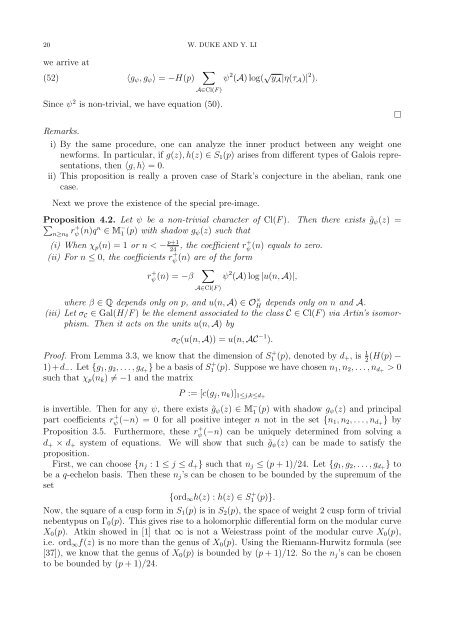Mock-modular forms of weight one - UCLA Department of Mathematics
Mock-modular forms of weight one - UCLA Department of Mathematics
Mock-modular forms of weight one - UCLA Department of Mathematics
Create successful ePaper yourself
Turn your PDF publications into a flip-book with our unique Google optimized e-Paper software.
20 W. DUKE AND Y. LI<br />
we arrive at<br />
(52) 〈g ψ , g ψ 〉 = −H(p)<br />
∑<br />
A∈Cl(F )<br />
Since ψ 2 is non-trivial, we have equation (50).<br />
ψ 2 (A) log( √ y A |η(τ A )| 2 ).<br />
Remarks.<br />
i) By the same procedure, <strong>one</strong> can analyze the inner product between any <strong>weight</strong> <strong>one</strong><br />
new<strong>forms</strong>. In particular, if g(z), h(z) ∈ S 1 (p) arises from different types <strong>of</strong> Galois representations,<br />
then 〈g, h〉 = 0.<br />
ii) This proposition is really a proven case <strong>of</strong> Stark’s conjecture in the abelian, rank <strong>one</strong><br />
case.<br />
Next we prove the existence <strong>of</strong> the special pre-image.<br />
Proposition<br />
∑<br />
4.2. Let ψ be a non-trivial character <strong>of</strong> Cl(F ). Then there exists ˜g ψ (z) =<br />
n≥n 0<br />
r + ψ (n)qn ∈ M − 1 (p) with shadow g ψ (z) such that<br />
(i) When χ p (n) = 1 or n < − p+1 , the coefficient 24 r+ ψ<br />
(n) equals to zero.<br />
(ii) For n ≤ 0, the coefficients r + ψ<br />
(n) are <strong>of</strong> the form<br />
r + ψ<br />
(n) = −β<br />
∑<br />
A∈Cl(F )<br />
ψ 2 (A) log |u(n, A)|,<br />
where β ∈ Q depends only on p, and u(n, A) ∈ O × H<br />
depends only on n and A.<br />
(iii) Let σ C ∈ Gal(H/F ) be the element associated to the class C ∈ Cl(F ) via Artin’s isomorphism.<br />
Then it acts on the units u(n, A) by<br />
σ C (u(n, A)) = u(n, AC −1 ).<br />
Pro<strong>of</strong>. From Lemma 3.3, we know that the dimension <strong>of</strong> S + 1 (p), denoted by d + , is 1 2 (H(p) −<br />
1)+d − . Let {g 1 , g 2 , . . . , g d+ } be a basis <strong>of</strong> S + 1 (p). Suppose we have chosen n 1 , n 2 , . . . , n d+ > 0<br />
such that χ p (n k ) ≠ −1 and the matrix<br />
P := [c(g j , n k )] 1≤j,k≤d+<br />
is invertible. Then for any ψ, there exists ˜g ψ (z) ∈ M − 1 (p) with shadow g ψ (z) and principal<br />
part coefficients r + ψ (−n) = 0 for all positive integer n not in the set {n 1, n 2 , . . . , n d+ } by<br />
Proposition 3.5. Furthermore, these r + ψ<br />
(−n) can be uniquely determined from solving a<br />
d + × d + system <strong>of</strong> equations. We will show that such ˜g ψ (z) can be made to satisfy the<br />
proposition.<br />
First, we can choose {n j : 1 ≤ j ≤ d + } such that n j ≤ (p + 1)/24. Let {g 1 , g 2 , . . . , g d+ } to<br />
be a q-echelon basis. Then these n j ’s can be chosen to be bounded by the supremum <strong>of</strong> the<br />
set<br />
{ord ∞ h(z) : h(z) ∈ S 1 + (p)}.<br />
Now, the square <strong>of</strong> a cusp form in S 1 (p) is in S 2 (p), the space <strong>of</strong> <strong>weight</strong> 2 cusp form <strong>of</strong> trivial<br />
nebentypus on Γ 0 (p). This gives rise to a holomorphic differential form on the <strong>modular</strong> curve<br />
X 0 (p). Atkin showed in [1] that ∞ is not a Weiestrass point <strong>of</strong> the <strong>modular</strong> curve X 0 (p),<br />
i.e. ord ∞ f(z) is no more than the genus <strong>of</strong> X 0 (p). Using the Riemann-Hurwitz formula (see<br />
[37]), we know that the genus <strong>of</strong> X 0 (p) is bounded by (p + 1)/12. So the n j ’s can be chosen<br />
to be bounded by (p + 1)/24.<br />
□
















